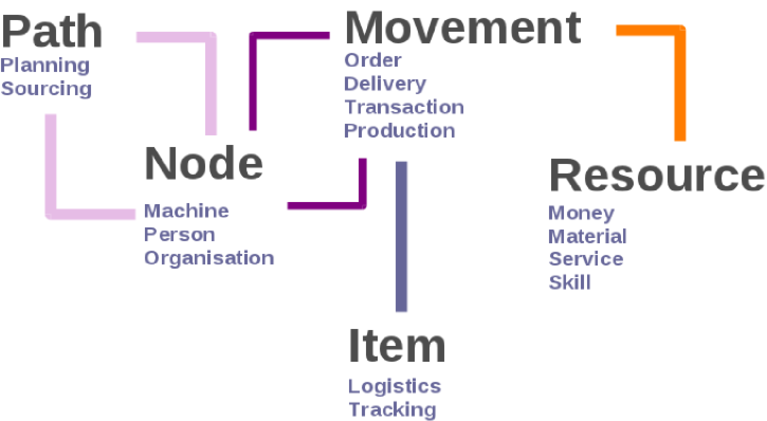Unified Business Model Design
The ERP5 Unified Business Model is used for accounting, warehouse
management, production and human ressource management in ERP5. All
features developed for one module are available in the other modules due
to the unified vocabulary which is independent of specific business
processes. ERP5's unified approach dramatically reduces the learning
curve and reduces the risk of data inconsistencies over multiple
modules.

This model is based on five abstract core classes :
-
Resource : a resource describes
an abstract resource in a business process like a raw material, a
product, a currency or an individual's skill.
-
Node : a node can receive and
send resources. It can relate to physical entities such as a
workshop or to abstract entities such as a bank account.
-
Movement : a movement describes a
movement of resources between two nodes at a given time and for a
given duration. For example, a movement might send raw material
from a warehouse to a workshop or money from one account to another.
-
Item : an item is a physical
instance of a resource. A movement can be expanded into a series of
traceable movements through items. Items are typically used to
handle serial numbers.
-
Path : a path defines a way for a node to access a
resource it might need. Prices and commercial profiles can be attached
to a path to define the default price for a given resource procured
by a given maker.
These abstract core classes are related to each other: A movement contains multiple items and is related to
a source node, a destination node and to a resource that is moved between the two nodes. Similar, a path
is related to a source and destination node and to the resource whose path attributes it defines.
Examples
It is useful to give you some examples, so that you can understand the model
better.
Example 1
Suppose that a company A wants to sell cameras to another company B. Once both
parties agree, the company A will send 10 cameras to the company B with the unit
price $100.
In this scenario, the companies A and B are considered Nodes. The product,
camera, is a Resource. The sales itself (ordering 10 cameras with $1000) is a
Movement. If this condition, such as the unit price, is agreed between those
companies, the condition is a Path. If the company A wants to trace the cameras,
it can attach a barcode for each camera, and this will generate 10 Items.
Example 2
Suppose that a company A wants to book-keep information about a wire-transfer
from another company B. The company B sent $1000 to the company A for a
receivable.
In this scenario, the accounts accounts receivable and bank account are Nodes,
physically speaking. The companies A and B are also Nodes, logically speaking.
The transfer is a Movement, and the money is a Resource. Item and Path are not
used here.
Example 3
Suppose that a company A wants to make 10 cameras from mechanical parts in a factory.
In this scenario, the factory is a Node. The cameras and the mechanical parts
are Resources. The production consists of two Movements, one for the consumptions
of the parts, and the other for the production of the cameras. For traceability,
the company A can put labels to the cameras and the parts, and these will be
Items. The transformation is described by a Path.
How is the Unified Business Model used in ERP5
The UBM is completely integrated into the implementation of ERP5. All documents
in ERP5 are designed, according to the model, and all tools and utilities in
ERP5 make use of the model to unify the implementation among various business
activities, such as trade, manufacturing, customer relationship management,
accounting, and project management.
This has made it feasible to rapidly develop new applications on ERP5, and
lower the maintenance cost at the same time, because all data shares the same
design architecture, thus the amount of code is dramatically reduced.